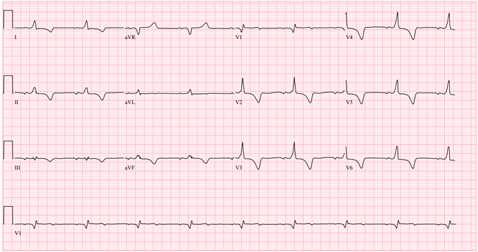University of Maryland Medical Center
EKG appearance and evolution of baseline EKG-characteristics in the worldwide first genetically modified porcine-to-human xenotransplant (“pig heart-in-human body”)
Oneib Khan1, Mahdokht Parsirad1, Calvin Kagan1, Richard Amara1, Muhammad Haq1, Susie Hong-Zohlman1, Manjula Ananthram1, Charles Hong1, Vincent See1, Stephen Shorofsky1, Timm Dickfeld1, Bartley Griffith2, Mohammad Mohiuddin2.
1Cardiovascular Medicine, University Of Maryland Medical Center, Baltimore, MD, United States; 2Surgery, University Of Maryland Medical Center, Baltimore, MD, United States
Introduction: The worldwide first genetically modified porcine-to-human cardiac xenotransplantation was performed in January 2022 at the University of Maryland with the recipient surviving for 61 days.
Methods: Daily 12- lead ECGs were obtained during the post-operative period.
Results: Accepted “pig heart-in-pig body” ECG parameters demonstrate a short PR interval (50-120ms), short QRS (70-90ms) and short QT (260-380ms). However, the first-ever EKG of a genetically modified heart xenotransplant (“pig heart-in-human body”) demonstrated a relatively longer PR interval of 190ms, QRS duration of 138ms and QT of 538ms (in setting of sinus bradycardia, interventricular conduction delay and inferior/antero-lateral T wave inversions; Figure 1). Prolonged intrinsic PR intervals remained stable during the post-operative course with 210±22ms [range 142-246ms]. However, atrial pacing demonstrated evidence of decremental intra-atrial conduction delay/AV-conduction delay most pronounced on day 12 (PR: 380ms). QRS duration remained prolonged with 145±16ms [range 116-192ms] but shortened during the post-operative course (day 21-40 vs 41-60: 148±14ms vs 132±11ms; p<0.001). Increased QT persisted with 509±54ms [range 384-650ms] with dynamic fluctuations (QT nadir around day 14 (428±22ms vs 533±36ms; p<0.001).
Conclusions: ECG parameters of the first genetically modified porcine-to-human cardiac xenotransplant (“pig heart-in-human body”) demonstrated prolongation over the usually encountered ECG measurements in the donor (“pig heart- in-pig body”) including changes in cardiac depolarization and repolarization. Prolonged ECG parameters persisted but showed dynamic changes during post-operative period. This provides a first insight into the novel and evolving field of xenotransplanation suggesting a complex interplay of inter-species physiology and porcine denervation in addition to post-surgical and medication-related changes.

Lectures by Oneib Khan
| When | Session | Talk Title | Room |
|---|---|---|---|
|
Sat-28 11:35 - 12:35 |
Miscellaneous topics 2 | Repolarization/ST segment characteristics in serial 12-lead EKGS in the worldwide first genetically modified porcine-to human xenotransplant | Indigo D |
|
Sat-28 11:35 - 12:35 |
Miscellaneous topics 2 | EKG appearance and evolution of baseline EKG-characteristics in the worldwide first genetically modified porcine-to-human xenotransplant (“pig heart-in-human body”) | Indigo D |
